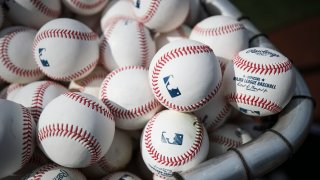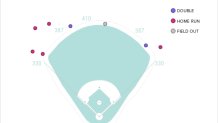
Jorge Alfaro knows what a home run feels like.
The Padres catcher, all 6’3” and 230 pounds of him, has hit 109 homers as a professional. On Saturday afternoon he thought he had another one. Alfaro ripped a shot at 115.2 MPH, one of the hardest balls hit in Major League Baseball this season. It had a launch angle of 20 degrees, plenty high enough to get out at Petco Park.
According to the statistical website Baseball Savant, similarly-struck balls fly out of the park five out of eight times and result in an extra-base hit seven out of eight times.
Guess which one the 8th was?
Get San Diego local news, weather forecasts, sports and lifestyle stories to your inbox. Sign up for NBC San Diego newsletters.

Alfaro’s missile was caught at the front of the warning track for an out. The look on his face was quizzical. He knew he’d hammered that ball. The problem might be that he hammered THAT ball.
“You did not hear players last season talk about the balls having dents or feeling squishy so there’s something about what they’re doing with this season’s baseballs that is different,” says Dr. Meredith Wills, a Harvard-trained astrophysicist and lifelong baseball fan who’s been studying big league baseballs for the last five years.
Local
Baseball players are vocalizing their displeasure with this year’s baseballs. Hitters hate them. The league-wide home run rate so far has taken its biggest dip in 34 years, even more dramatic than when MLB started testing for performance-enhancing drugs.
But pitchers, who are supposed to be the beneficiaries of less offense, might hate them even more. The biggest complaint is a lack of consistency in the ball, leading to potential control issues. In late April, Mets starter Chris Bassitt let his frustrations out.
“MLB has a very big problem with the baseballs. They’re bad. Everyone knows it. Every pitcher in the league knows it. They’re bad. MLB doesn’t give a damn about it. We’ve told them our problems with them. They don’t care. They’re all different. The first inning they’re decent. The third inning they’re bad. The fourth inning they’re OK. The fifth inning they’re bad. There’s no common ground with the balls, nothing the same. Outing to outing they’re bad,” said Bassitt.
Keep in mind, that was after he threw 6.0 shutout innings and got a win.
To understand what’s going on we need to go into a little bit history. The issue really came to light in 2017 when MLB saw a home run surge. The league had a study done to figure out why. Scientists discovered the baseballs were creating less drag.
“What that means is it doesn’t slow down as fast when it’s traveling through the air,” says Wills. “That’s when I got involved. I’ve been taking baseballs apart and I discovered that the red laces for the 2017 balls were thicker than before. In this case I compared it to 2014. It turns out that seems to have made a difference. It looks like it was actually keeping the ball rounder.”
So, in 2018, Major League Baseball (with financial help from Seidler Equity Partners, which was co-founded by Padres owner Peter Seidler) bought the Rawlings factory that makes the balls. They say it was to ensure consistency in manufacturing.
Players and scientists like Dr. Wills say that’s not happening.
MLB confirmed for a couple of years they made two different kinds of balls, which they say was by accident due to manufacturing issues at the plant. In 2020, only 60 games were played but a full season’s-worth of balls were made. Wills theorizes that the excess of baseballs for the 2020 season was utilized throughout 2021, along with the balls made for 2021. She has studied several balls from that season and saw wild inconsistencies.
“They used them all season long, including two kinds of baseballs in the same games. They’d have them in the same innings, it was nuts,” says Wills.
In 2022, MLB says every ball is conforming to all official specifications in its rule book. However, players say some balls are so squishy they can push the cover around.
“The way that they changed the construction is, it looks the same on the inside, except the innermost layer is wound more loosely so the ball is lighter while the size is the same,” says Wills.
Less density and weight lead to less carry on the ball. But, there’s another factor to consider. Part of the problem this year could be attributed to another change the league instituted without much trial and error: humidors.
This year the league mandated all 30 MLB parks keep baseballs in a humidor. It’s already been done in places like Denver and Phoenix for years to try and battle the elements that are more conducive to home runs. But, Wills hypothesizes when players discuss flat spots or dents on the balls, it could be due to MLB mandating every ball sit in a humidor for at least 14 days, softening while it sits on one spot.
The humidor could also be impacting drag, which brings us back to Jorge Alfaro. On Mother’s Day, he hit a no-doubt walkoff home run. That ball had a 28 degree launch angle, came off the bat at 113 MPH … and traveled 449 feet, a full 60 feet farther than the one he hit on Saturday with warmer temperatures inside Petco Park.
Physics says those two baseballs should not have had such drastically different flights. But, this new baseball seems to be full of unknowns and inconsistencies … and unfortunately not many answers as to why.
“We actually don’t know how it travels on its own because it’s never been used on its own. It’s never even been tested for that,” says Wills. “They tested it in a lab, it was all indoors, temperature and climate controlled, nothing outdoors, no drag testing at all. We still don’t know how the drag legitimately compares, certainly not without the humidors.”
Wills says, as a scientist, she is not going to drop this until there’s a solution. She’s also asking anyone who catches a foul ball at a big league game to send it to her for testing. If anyone is willing to do that, contact me via Twitter @DerekNBCSD or email at derek.togerson@nbcuni.com and I will help facilitate getting the ball to her.
If we can get to the bottom of this and offense returns to something resembling normal, I’m sure Jorge Alfaro and Chris Bassitt will thank you.
LISTEN: With NBC 7 San Diego's Darnay Tripp and Derek Togerson behind the mic, On Friar will cover all things San Diego Padres. Interviews, analysis, behind-the-scenes...the ups, downs, and everything in between. Tap here to find On Friar wherever you listen to podcasts.



